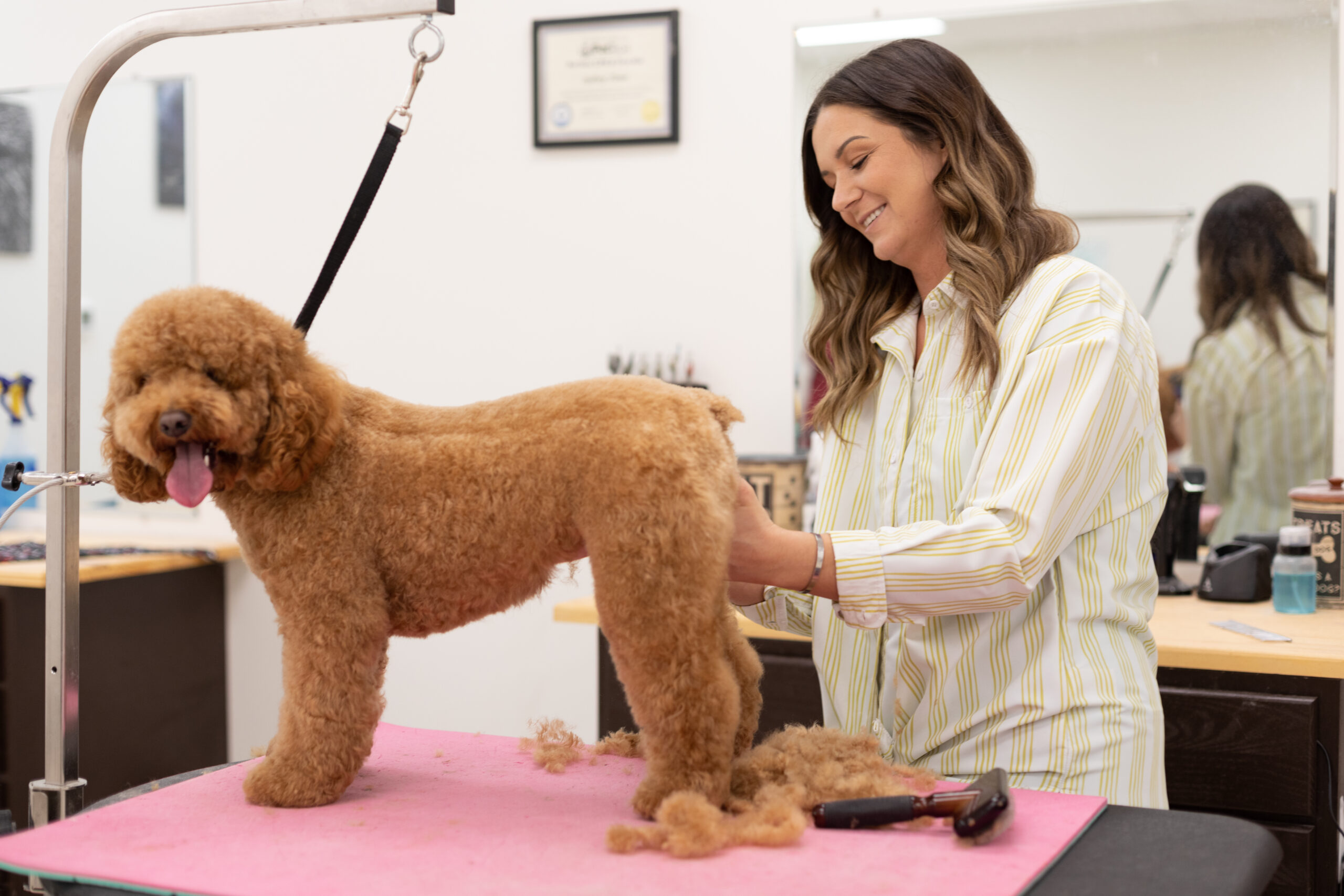Why Goldendoodles Need Regular Grooming
Grooming is essential for goldendoodles, celebrated for their stunning coats that range from curly to wavy to straight. The unique blend of poodle and golden retriever requires tailored grooming techniques to stay healthy and looking fabulous. In this blog, we’ll dive into the specific grooming needs of goldendoodles, share must-have maintenance tips, recommend the best tools and provide guidance on communicating with professional groomers to ensure your pet looks its absolute best!
Do Goldendoodles Need Grooming?
Yes, goldendoodles require regular grooming and are considered one of the most high-maintenance dog breeds when it comes to coat care. Their unique coats, which can range from curly to wavy or straight, require consistent upkeep to prevent matting and maintain healthy skin.
Understanding Goldendoodle Coat Types and Skin Problems
Goldendoodles can have a variety of coat types, each with different grooming needs:
- Curly Coats: Similar to the tight spiral curls of a poodle, curly doodle coats are low-shedding and less allergenic but require daily brushing to prevent matting.
- Wavy Coats: These fall between straight and curly, forming gentle waves. While lower maintenance than curly coats, they still require brushing a few times a week to prevent tangles and maintain shape.
- Straight Coats: Though less common, straight coats are easier to manage and require less frequent brushing, though regular grooming is still essential to keep them healthy and free from mats.
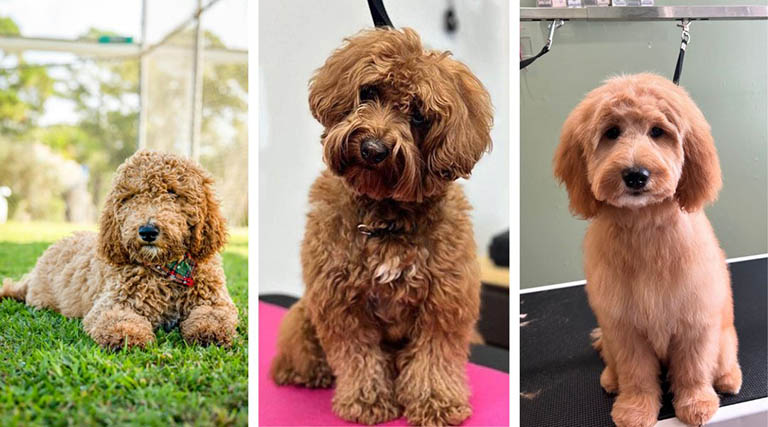
The Challenge of Mixed Coats
Many doodles inherit mixed coat types, blending different textures like curly, wavy or straight hair across their bodies. For example, a doodle may have straight hair on their face and tail but curly fur on their body. This combination coat is what makes goldendoodle grooming complicated, requiring tailored techniques and products to care for the varying textures properly.
Preventing Matting in Goldendoodles
Matting occurs when fur tangles into clumps, trapping dead hair and becoming tighter over time. Doodles, with their mix of curly and double coats, are especially prone to matting. Left unchecked, mats can cause discomfort, skin infections and dandruff, while also providing hiding spots for parasites like fleas and ticks. Wet fur from rain, snow or even doggy coats and harnesses can exacerbate the problem, making regular brushing and grooming essential to keep mats at bay.
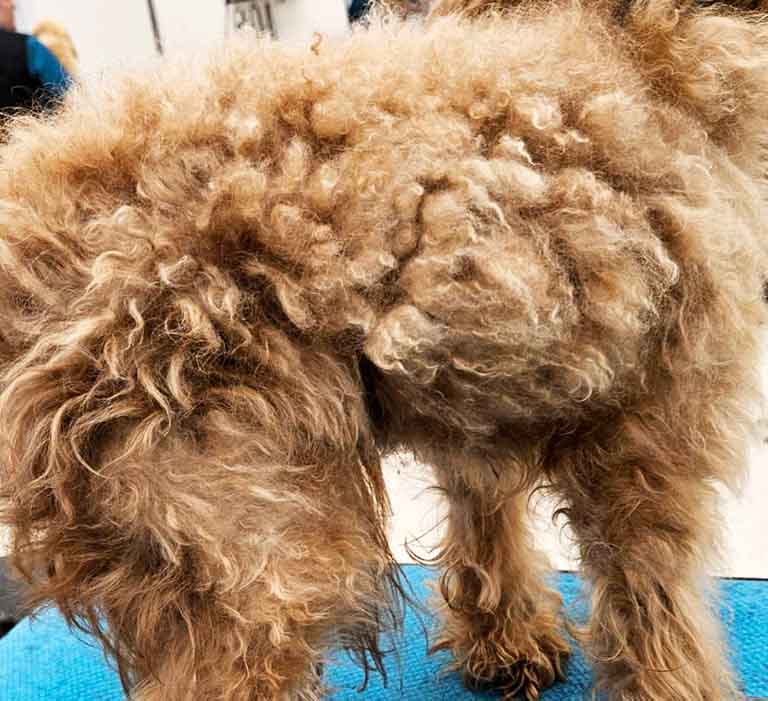
Do Goldendoodles Have Allergies?
Goldendoodles are prone to environmental and food allergies, which can lead to skin irritation and dryness. If left untreated, these issues can escalate into infections. Common signs of skin problems include redness, itching, dandruff, sores and persistent odors. Many doodles inherit their sensitivity from their parent breeds of golden retriever and poodle.
Ear Care for Goldendoodles
Due to their droopy ears, which can trap heat, moisture and debris, goldendoodles are susceptible to chronic ear infections. This trait is inherited from their golden retriever and poodle lineage. Symptoms of ear infections include frequent head shaking, pawing at the ears, redness, foul odor and moisture buildup. Keeping their ears clean and dry is essential for preventing discomfort and bacterial growth. Learn more about dog ear infections here.
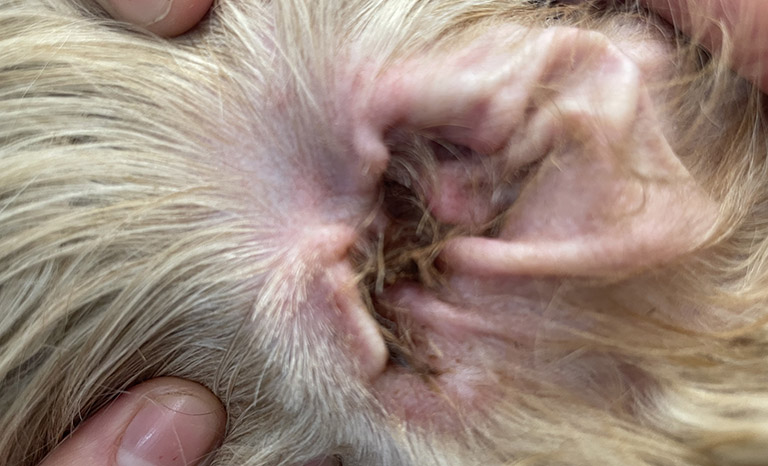
How Often Should Goldendoodles Be Groomed?
Establishing a regular grooming routine is essential for doodles due to their tendency to mat and their vulnerability to skin and ear infections. Regardless of coat type, doodles should be groomed every 4-6 weeks, with longer coats requiring even more frequent care. Consistent grooming helps maintain both coat and skin health, highlighting the importance of sticking to a structured grooming schedule.
Grooming a Goldendoodle
Brushes for Goldendoodles
- Slicker Brush:
The slicker brush is highly effective for detangling and removing loose hair, reducing the risk of matting. It’s particularly useful for doodles with thick, curly or combination coats. This brush helps manage their unique fur texture and ensures a smoother grooming process.
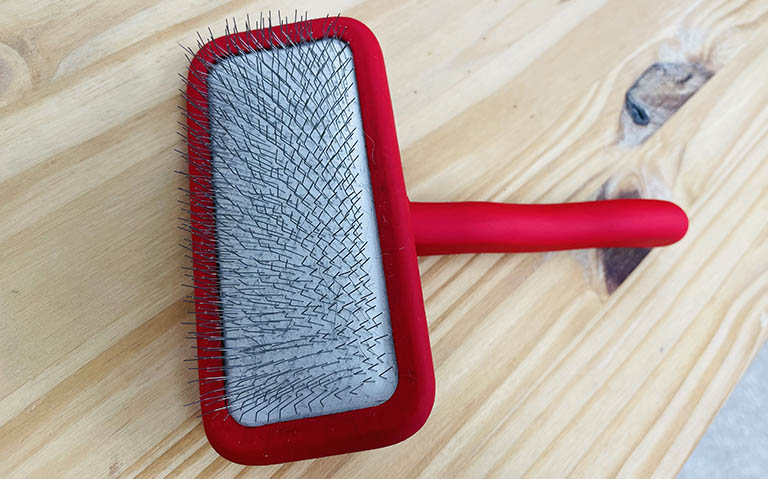
- Metal Comb:
After using the slicker brush, follow up with a metal comb. A fine-toothed comb works well for dematting and tackling any knots missed by the slicker brush. When combing, always move in the direction of hair growth and ensure the comb reaches the base of the coat to gently touch the skin for thorough grooming.
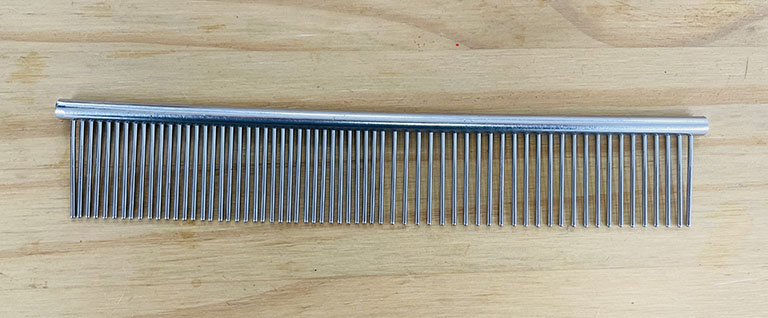
How to Brush a Goldendoodle
When brushing your goldendoodle, use soft, gentle strokes, applying the same pressure you would on your own arm. Focus on key areas where mats often form, such as the ears, neck, chest, legs, butt and tail. Always brush in the direction of the coat’s growth to avoid causing discomfort or breakage.
After using the slicker brush, follow up with a metal comb to catch any remaining tangles. Work in small sections of hair to make the detangling process easier and more effective. You should brush your goldendoodle daily to maintain a healthy coat and prevent matting.
How Often to Bathe a Goldendoodle?
Goldendoodles should be bathed every four weeks to maintain healthy skin and a clean coat. Regular bathing not only helps remove dirt and debris but also keeps allergens at bay, reducing the risk of skin irritation. Sticking to a consistent bathing schedule ensures your goldendoodle’s coat remains manageable and free of excess oils, while also supporting overall coat and skin health.
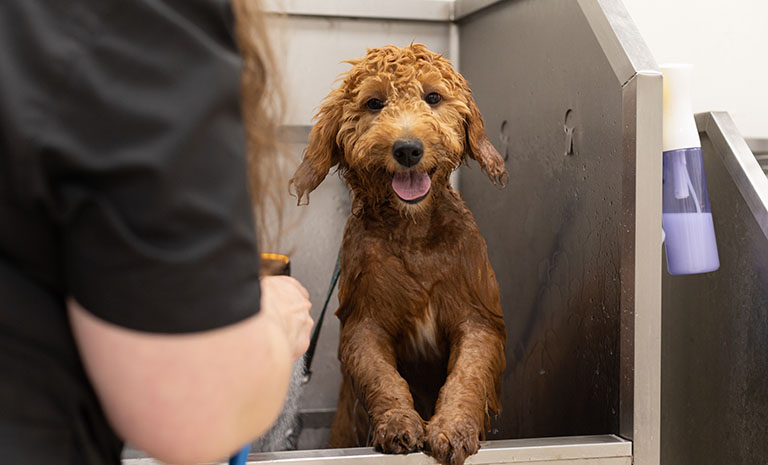
Best Goldendoodle Haircuts
To effectively communicate your desired goldendoodle haircut, start by identifying your dog’s coat type. Then, find pictures of similar doodles with the same coat and show them to your groomer. Be clear about what you want while keeping expectations realistic based on your dog’s coat.
When discussing length, avoid vague terms like “close shave” or “long hair,” as these can vary. Instead, specify how much hair you want left on areas like the ears, tail, face, feet, and body. Talk about guard lengths with your groomer to ensure you’re both aligned on the look you want.
Panda Clip or Teddy Bear Trim: Many doodle owners prefer the Panda Clip or Teddy Bear Trim, which features a closely clipped body with longer, fluffy legs and a round face, often paired with short ears. When requesting this style from your groomer, describe it as a shorter body with fuller legs and a rounded facial shape. Bringing a photo for reference can help ensure you get the exact look you want.
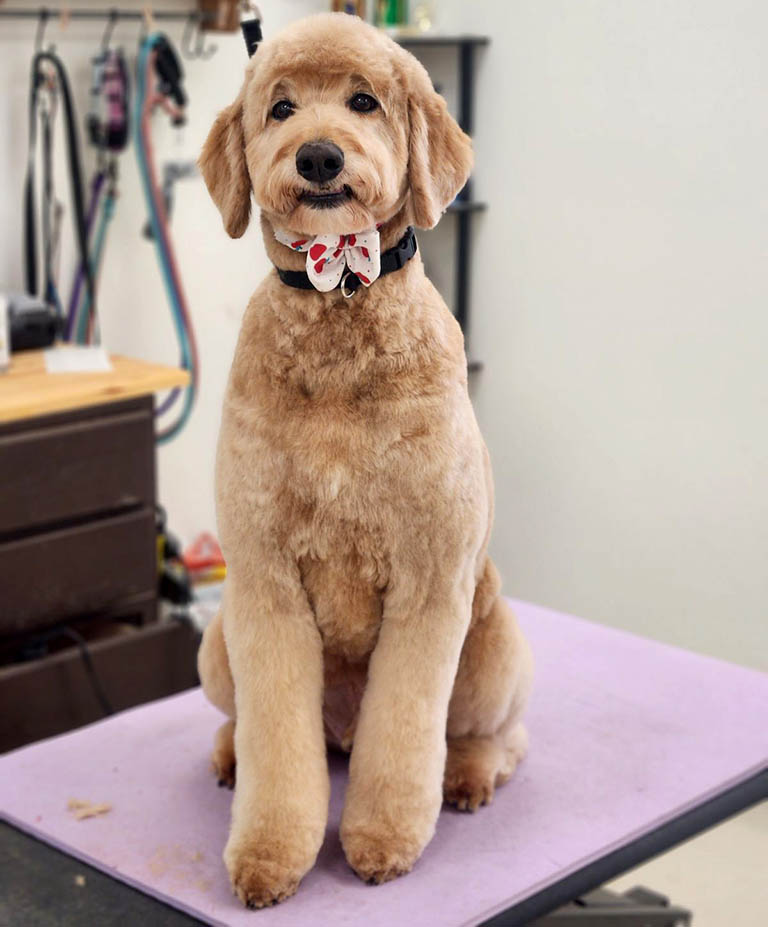
Retriever Trim or Puppy Trim: The Retriever Trim, also known as a Puppy Trim, involves keeping the fur at a uniform length across the body, typically on the shorter side. Since “short” can mean different things to different people, it’s important to clearly specify the length you’re looking for. This trim is versatile and usually involves even-length fur on the body and legs, with special attention to shaping the head.
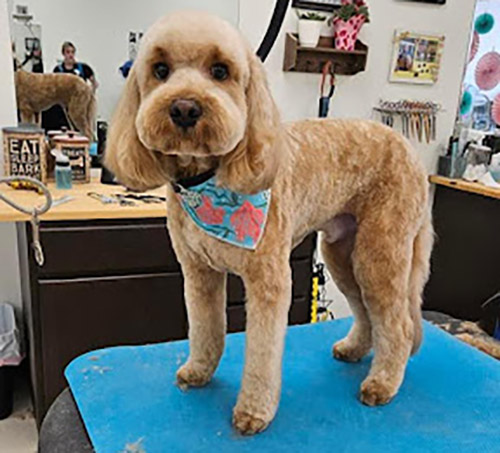
Can You Shave a Goldendoodle?
Some doodle owners opt for a full shave, especially if their dog frequently swims or for easier maintenance. In cases of severe matting, a full shave may be necessary for the dog’s comfort and safety. Groomers will use blades that safely separate the coat from the skin, often leaving about ¼ inch of hair or even less, depending on the severity of the matting. Groomers always aim to keep the dog comfortable while maintaining a neat appearance.
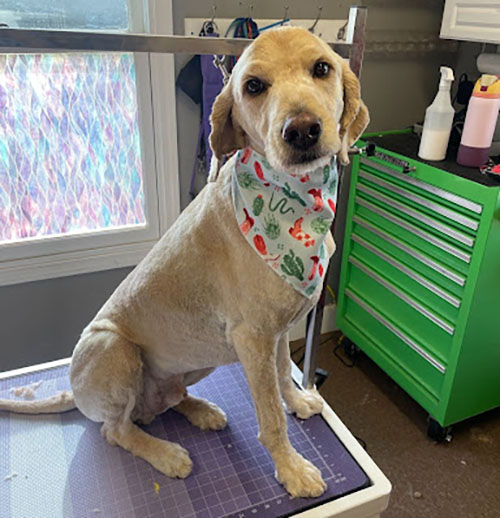
Professional Grooming for Goldendoodles
Doodle Groomers
Choosing a groomer experienced with doodles is essential, as these dogs often have unique coat needs that vary between curly, wavy and straight textures. An experienced doodle groomer knows how to manage combination coats, prevent matting and recommend the right products for maintaining coat health between appointments.
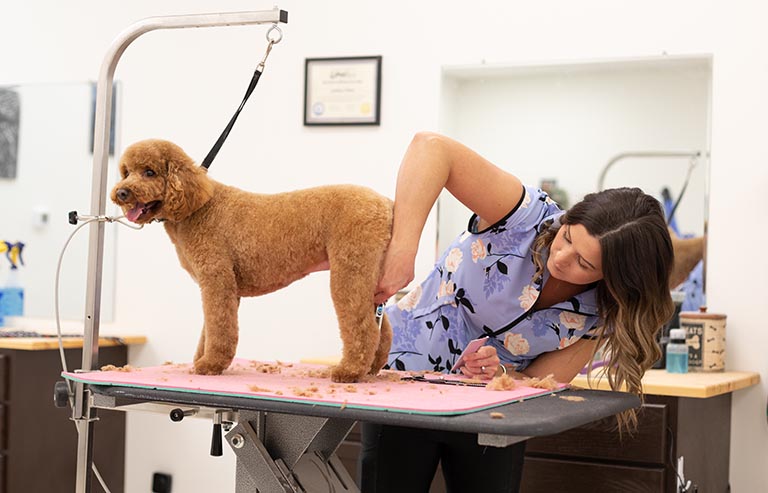
What to Expect from a Professional Grooming Session
During a professional grooming session, your doodle will typically receive a full bath, blow-dry, brush-out, nail trim and haircut. The groomer will focus on removing mats, trimming around sensitive areas like the eyes and paws, and ensuring that the coat remains healthy and well-maintained. You’ll also have the chance to discuss specific haircut preferences.
Full-Grown Goldendoodle Grooming
Grooming a full-grown goldendoodle differs from puppy care due to the mature coat’s thicker, denser nature. Full-grown doodles often require more frequent brushing and trimming to manage their coats, especially in areas prone to matting like the legs and chest. Puppies, on the other hand, have softer, fluffier coats that are easier to maintain but will eventually transition from their puppy coat into their adult coat between 4-8 months old.
We recommend bringing puppies in for grooming after their second round of shots, typically around 10-12 weeks old. Starting early helps puppies get accustomed to the grooming process, making future visits smoother and less stressful. At Smoochie Pooch, we also offer a special discount on our basic grooming package for puppies 6 months and younger.
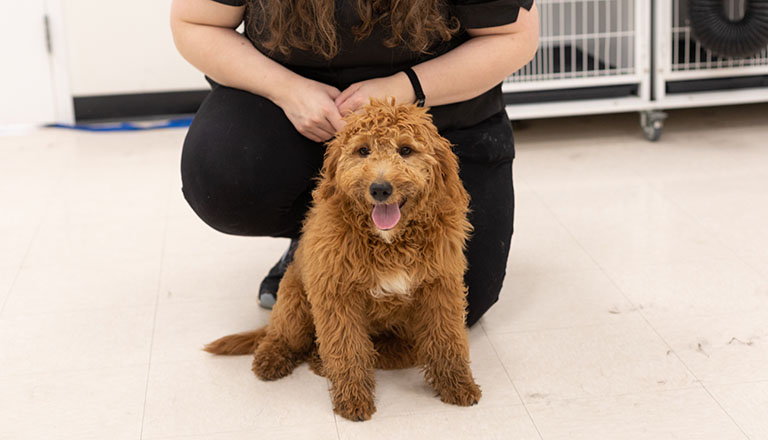
Mini Goldendoodle Grooming
Mini goldendoodles, although smaller in size, have grooming needs that closely mirror those of their larger counterparts. They require the same regular brushing, bathing and grooming, as well as the same attention to skin and coat issues. The primary difference is that grooming sessions for mini goldendoodles may be shorter than those for larger goldendoodles.
Grooming GoldenDoodles
Keeping a regular grooming routine for your goldendoodle is crucial for their skin and coat health. By familiarizing yourself with their unique coat types and grooming needs, you can help your dog look and feel their best. Whether you’re brushing at home or taking them to a professional groomer, consistent care will prevent problems like matting and skin irritations. Use these helpful tips and insights to maintain your goldendoodle’s appearance


